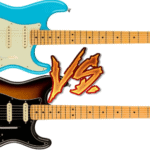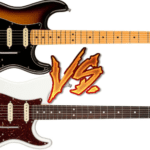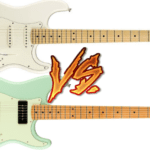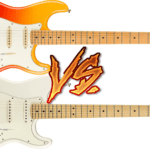There are a lot of technical terms and measurements when it comes to guitar construction and it can be difficult to sort out the differences sometimes.
But since the Fender Stratocaster and “S-type” guitars are among the most popular of all time, let’s take a look at the tremolo bridge and just what the difference is between Fender’s 2-point and 6-point design.
The 6-point tremolo bridge was the original choice for Fender Stratocaster guitars but was later replaced by the 2-point style in order to improve tuning stability. The idea was to reduce the number of friction points for smoother movement (fewer problems!) when using the tremolo arm.
Before we explore the tremolo system further, perhaps a quick explanation of what exactly it is would be helpful. What does it do and how does it work?
It is industry standard to refer to the tremolo bridges on guitars but the effect is actually vibrato (changing the pitch whereas tremolo refers to a change in volume).
The tremolo arm on a Stratocaster allows you to introduce friction which affects the vibration of the strings and changes the pitch, not the volume.
What do points mean on a Stratocaster tremolo bridge?
When Fender began using tremolo bridges, the bridge was screwed into the body of the guitar with 6 screws (points) in a line, creating the fulcrum which allows the player to “detune” the strings.
But getting too crazy with the tremolo often caused the guitar to go out of tune.
After all, we are talking about rubbing metal on metal with no lubricant and tension from strings and springs pulling in opposite directions.
As higher gain amps and extreme tremolo became popular in rock music, Fender decided to move to a system using two posts (points) screwed into the body instead of the 6-screw method.
This allowed the redesigned bridge’s “knife edge” to pivot against the two posts rather than rocking the 6-point bridge along the posts of the smaller screws.
When did Fender use 6-point tremolos?
The 6-point tremolo system goes all the way back to 1954 when Fender released the Stratocaster model.
Tremolo for guitar has its roots in the late 1920s and had found some success with the Bigsby design but Leo Fender designed the synchronized tremolo system to give more tonal range and to be partially recessed into the guitar body as opposed to the Bigsby, which sits on top of the guitar.
Through the 1950s and 1960s Fender would go on to try different tremolo systems with their other models such as the Jazzmaster and Jaguar but the Stratocaster style became a classic.
Comedy fans may remember the “64 Fender Stratocaster in classic white with triple single-coil pickups and a whammy bar” that was featured in the film Wayne’s World.
When did Fender use 2-point tremolos?
By the 1980s the way that tremolo was used had evolved and Fender needed some way to ensure that their Strats stayed in tune with heavy trem use.
Some of the factors that led to this were probably the appearance of the Floyd Rose tremolo system in the 1970s and the popularity of bands such as Van Halen and other shred-style guitarists.
They weren’t playing Strats anymore; they were playing Super-Strats with active pickups and Floyd Rose locking tremolos.
Fender switched to the 2-point tremolo in 1986 to address tuning stability and to make their instruments more attractive to the new style of players.
The company has mostly stuck to this construction until today with some tweaks to the string saddles in 2008.
Main differences between 2 and 6-point tremolos?
Fans of the 6-point tremolo style may argue that it provides better sustain since more of the bridge is against the body of the guitar whereas the 2-point style “floats” a little more.
On the other hand, some say the 2-point style has more mass and thus produces a stronger resonance that way.
The saddles for the strings may also be different: bent steel saddles on the 6-point bridges and either solid steel or bent steel on the two-point bridges, depending on the year of the model.
Regarding the manufacturers, producing the classic 6-point tremolo was a little simpler but that isn’t something that the player has to worry about too much.
Are 6-point tremolos really better?
With today’s huge interest in vintage instruments, there is definitely still a market for the older style, especially for fans of music from the 1950s through 1970s. If the classic bands of those days didn’t need 2-point tremolos then why should you?
Fender still produces 6-point bridges, especially for artist models for the likes of Jimi Hendrix, Eric Clapton, and others. It is also worth noting that Squier’s popular Classic Vibe series uses the 6-point tremolo system while the cheaper Affinity series has 2-point trems.
A more practical consideration is that some players don’t even use the tremolo and want to “lock it down”, which is easier to do than on the 2-point version.
Is there any reason to prefer a 2-point tremolo over a 6-point tremolo?
The newer 2-point tremolo’s main strength is better tuning stability.
But the updated design provides some wiggle room for pulling up as well as down on the tremolo bar so you can bend the pitch up or down. You’re probably not going to pull off huge dive-bombs on the Strat whammy bar without some tuning trouble but the design is a nice middle point between the 6-point and the (nightmare to set up and change strings) locking tremolo like the Floyd Rose bridge.
Consider this: after Leo Fender sold his namesake company and started the G&L guitar company in the late 1970s, he continued to use the 2-point tremolo style so I think it is safe to say that Mr. Fender himself preferred it.
Should you really care about the kind of tremolo bridge on a Strat?
For the average player who uses the tremolo effect subtly, there is not a massive difference in the two styles but at least now you don’t have to stand there blinking the next time someone says “6-point tremolo” at your local music shop.
If you are unsure of which is the right choice for you, then it is probably best to visit your local instrument shop and do an A/B comparison between both styles to see if you can feel/hear a difference.
You can even find some Strats with fixed bridges if tremolo isn’t part of your style.
If you live in an area where online shopping is more convenient then you can probably figure out what is best for you based on the music you like to play and listen to.
If you are a big Van Halen fan then the 2-point style is probably for you but if you are happier listening to The Beatles or Pink Floyd then the original 6-point bridge should be just fine.

Hello there, my name is Ramiro and I’ve been playing guitar for almost 20 years. I’m obsessed with everything gear-related and I thought it might be worth sharing it. From guitars, pedals, amps, and synths to studio gear and production tips, I hope you find what I post here useful, and I’ll try my best to keep it entertaining also.





